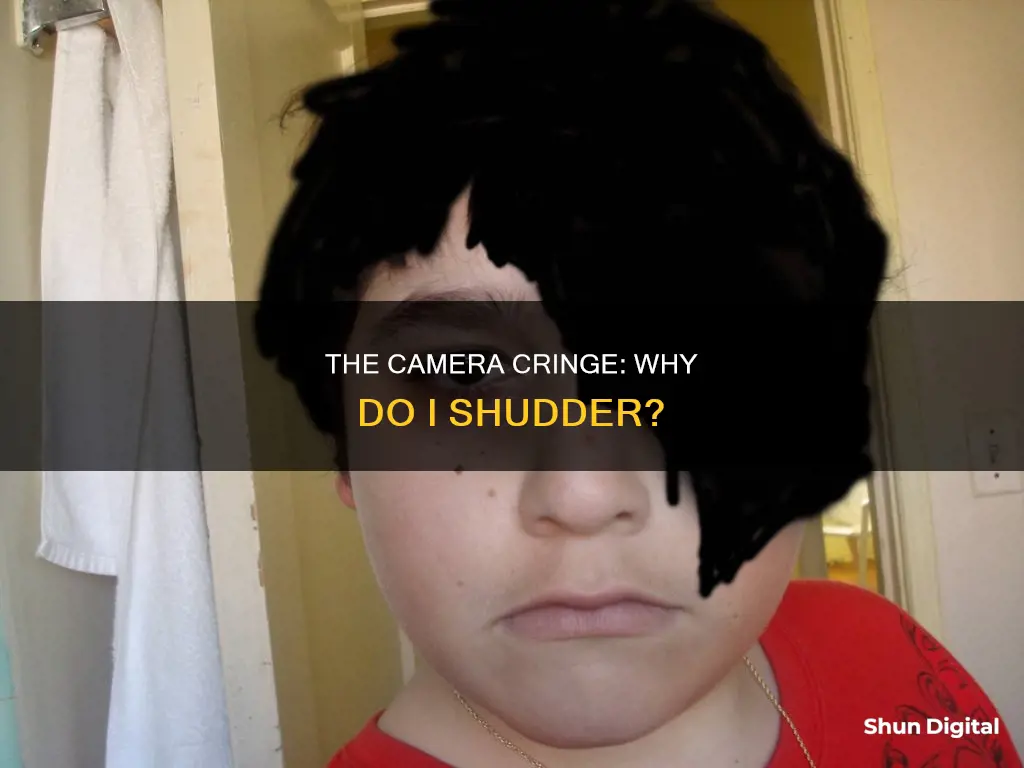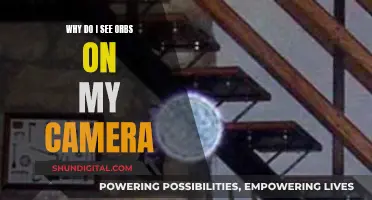
Many people experience discomfort when seeing or hearing themselves on video or camera. This phenomenon is known as the cringe factor and is caused by a sudden shift in perspective. When we see ourselves on camera, we are seeing our true image, as opposed to the flipped image we are used to seeing in the mirror. This creates a jolt to the system, sometimes even mild anxiety, as our brains react to the lack of recognition and familiarity. Additionally, we are unaccustomed to hearing our real voice, as the way we perceive our voice is often deeper and more resonant than it actually is. Finally, self-talk plays a role in the cringe factor, as we tend to view others more positively than ourselves, focusing on their content rather than their delivery.
| Characteristics | Values |
|---|---|
| A sudden shift in perspective | Our brains react with mild anxiety, or what psychologists call "cognitive dissonance" |
| The "Mere Exposure Effect" | We are used to seeing a mirrored image of ourselves, which looks different from how others see us |
| We aren't used to hearing our real voice | Our voice sounds different to us because it travels through our skull and our ear canals |
| Confirmation bias | We focus on things that confirm our negative biases about ourselves |
| Familiarity principle | We prefer and trust things, products, and people that are familiar to us |
What You'll Learn

We see our face as others see it, which is a jarring shift in perspective
The human brain is a complex organ that processes information at lightning speed. However, this rapid processing sometimes results in errors and biases that influence our perceptions and decisions. One intriguing phenomenon is the cringe-worthy feeling many individuals experience when seeing themselves on camera or hearing their recorded voice. This aversion can be attributed to three primary factors, with the first being the jarring shift in perspective that occurs when we view ourselves through another's lens.
Typically, we observe our faces in mirrors, which present a horizontally flipped image. Over time, we become accustomed to this "mirror image," accepting it as our true representation. However, when we see ourselves on camera, we encounter our actual appearance, as perceived by others. This sudden change in perspective can be startling, leading to a sense of dissonance and discomfort. The asymmetry of our faces further exacerbates this effect, as the two images—the mirrored and the true—appear noticeably different, triggering a jolt of mild anxiety.
This shift in perspective is not merely visual but also auditory. The way we hear our voice when we speak differs significantly from how others hear it. Approximately 15% of our voice travels through our skull, resulting in a deeper and warmer tone for ourselves. Consequently, when we hear our recorded voice, it often sounds squeaky, thin, and unfamiliar, contributing to the cringe-worthy sensation.
The second factor is the Mere Exposure Effect, also known as the Familiarity Principle. This concept suggests that we develop preferences for things due to familiarity. In the context of self-perception, we are accustomed to the mirrored image we see daily, and this familiarity breeds comfort and acceptance. However, when we view ourselves on camera, we are confronted with a slightly different version of our appearance, leading to feelings of unease and strangeness.
The third factor is confirmation bias, which refers to our tendency to seek, interpret, and recall information that aligns with our existing beliefs and expectations. When we feel self-conscious about our appearance, we tend to focus on and exaggerate perceived flaws, ignoring positive aspects. This bias can amplify negative feelings about our on-camera presence, reinforcing the cringe-worthy sensation.
While the cringe factor is common, it is important to recognize that it is not an accurate reflection of our true selves. By understanding the psychological and physiological factors at play, we can take steps to overcome this discomfort and embrace the unique version of ourselves that we present to the world.
Home Security: Watching Your Home from Another State
You may want to see also

We hear our voice differently to how others hear it
Many people experience discomfort when they see or hear themselves on video or recording. This phenomenon is called voice confrontation, and it can be explained by a few factors. Firstly, there is a difference in how we hear our voice compared to how others hear it. When we speak, sound travels through our vocal chords, out of our mouths, and reaches our ears through a process called air conduction. However, we also hear our voice through bone conduction, as the sound is conducted internally through our skull, providing rich low frequencies that are absent in the air-conducted vocal sound that others hear. As a result, our recorded voice sounds higher and thinner to us, differing from our expectations and leading to discomfort.
Additionally, the image we see of ourselves on camera is not the version we are accustomed to seeing in the mirror. Our faces are not perfectly symmetric, and the mirror image we are used to seeing is flipped horizontally by 180 degrees compared to how others see us. This discrepancy creates a jolt of mild anxiety, a psychological phenomenon known as cognitive dissonance, as our brain struggles to reconcile the familiar mirror image with the true image captured on camera.
The Mere Exposure Effect also plays a role in our discomfort. This effect suggests that we develop preferences for things due to familiarity. We are constantly exposed to our mirror image and become accustomed to it, favouring it over the true image we see on camera. This discrepancy between our expected and perceived image can lead to a jarring experience, contributing to the cringe factor.
Furthermore, the sound and image of our recorded selves can reveal aspects of our personality that we may not be fully aware of, such as anxiety, indecision, or other emotions conveyed through extra-linguistic cues. This sudden realisation can be disconcerting and lead to self-evaluation and social comparison, potentially resulting in dissatisfaction or upset.
While it is natural to experience some discomfort when seeing or hearing ourselves on camera, it is important to remember that others are not typically critical of our voices or appearances. Overcoming this fear involves taking imperfect action, showing up on camera, and gradually getting used to seeing and hearing ourselves as others do.
Accessing and Viewing CC Camera Footage: A Step-by-Step Guide
You may want to see also

We focus on confirming our negative biases
The cringe factor is a common phenomenon, and it occurs due to a sudden shift in perspective. When we see ourselves on camera, we experience ourselves from the outside in, which can cause mild anxiety or cognitive dissonance. This is because we are so used to seeing a mirrored version of ourselves, which is not how others perceive us. This discrepancy between our self-image and how we appear to others can be jarring and lead to feelings of discomfort and self-criticism.
We tend to focus on confirming our negative biases, and this tendency is heightened when we view ourselves on camera. Confirmation bias is a concept that explains our propensity to seek out, interpret, and recall information that aligns with our pre-existing beliefs and expectations. When we see ourselves on camera, we often pay attention to the aspects that confirm our biases and negative self-image. We may go into a video shoot feeling self-conscious about our appearance, and when reviewing the footage, we will likely focus on the things that reinforce these insecurities. This can lead to an excessive focus on minor flaws and imperfections, which we may perceive as evidence of awkwardness or other negative qualities.
The mere exposure effect also plays a role in our preference for the mirror image. This effect suggests that we develop a liking for things simply because we are familiar with them. Over time, we become accustomed to seeing our mirrored self-image and accept it as our true representation. However, when we see ourselves on camera, we are confronted with a different version of our appearance, which can be unsettling and trigger the cringe response.
Additionally, the way we perceive our voice contributes to the cringe factor. Due to the conduction of sound through our skull, we hear our voice differently from how others do. We are used to the deeper, warmer tone that we hear internally, so when we hear our recorded voice, it can sound strange, thin, and high-pitched to us. This discrepancy between our expected and actual voice can further contribute to the discomfort we feel when seeing ourselves on camera.
To overcome the cringe factor, it is important to recognize that everyone experiences it to some degree, even seasoned presenters and actors. By understanding the psychological and physiological reasons behind this phenomenon, we can work on responding to our feelings in a more positive and constructive way. We can also seek feedback from others and gradually expose ourselves to seeing and hearing ourselves on camera to build familiarity and reduce discomfort.
The Boss Watches: Cameras Capture Every Move
You may want to see also

We are more familiar with our mirror image
The image we see in the mirror is actually flipped, or a mirror image of our face, horizontally rotated 180 degrees. So when we see ourselves in a mirror, we are not seeing our true image, but we get used to this reflected version of ourselves. When we see ourselves on camera, we see our face the way other people see it, and this can look very different. Our brains react to this lack of recognition and familiarity with a jolt of anxiety, and we experience the 'cringe factor'.
The fact that no one's face is symmetrical means that the mirror image we are used to seeing is different from our true image. This difference can be quite jarring when we see ourselves on camera. We are so used to the flipped image that our true image can seem very unfamiliar and strange.
Additionally, the way we perceive our voice is often deeper and more resonant than what we actually sound like to others. When we hear our recorded voice, it can sound thin and high-pitched. This is because, when we speak, about 15% of our voice travels through our skull, and so we hear our voice differently from how others hear it.
The combination of seeing an unfamiliar image of ourselves and hearing our voice differently can create a strong sense of dissonance and discomfort, leading to the cringe factor many people experience when seeing themselves on camera.
Hisense 4K TV: Are There Built-In Cameras?
You may want to see also

We are self-critical of our delivery rather than our content
It's natural to cringe when you see yourself on camera. This phenomenon is called "cognitive dissonance", a sudden shift in perspective that causes mild anxiety. There are several factors at play, including the mere exposure effect, confirmation bias, and the way we perceive our appearance and voices.
Firstly, we are used to seeing a mirrored image of ourselves, which is flipped horizontally by 180 degrees. This image differs from how others see us and how we appear on camera. When we view ourselves on video, the sudden change in perspective can be jarring, as we are confronted with a version of ourselves that seems unfamiliar. This discrepancy between our self-image and reality triggers cognitive dissonance, leading to feelings of discomfort and cringe.
Secondly, the way we hear our voices also contributes to the cringe factor. When we speak, our voices reach our ears through two pathways: air conduction (sound travelling through the air) and bone conduction (sound travelling through our skulls). Bone conduction gives us the perception that our voices are deeper and warmer. However, when we hear ourselves on a recording, we only hear the air-conducted voice, which sounds thinner and higher-pitched. This discrepancy between our expected and actual voice can be off-putting.
Additionally, we tend to be self-critical of our delivery rather than our content. We often focus on minor flaws in our appearance or delivery, such as feeling self-conscious about our hair, skin, or weight. This confirmation bias, where we seek out information that confirms our existing beliefs or insecurities, can amplify our negative self-perception.
To overcome these feelings of cringe, it's important to remember that even seasoned presenters and actors experience similar discomfort. By repeatedly exposing ourselves to our true image and voice, we can gradually adjust to them and reduce the cringe factor.
Visio TV Camera: How to Spot It
You may want to see also







